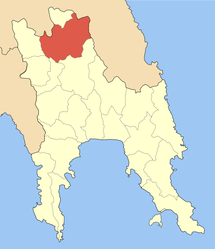- Oinountas
-
Oinountas
ΟινούνταςLocation Coordinates 37°10′N 22°25′E / 37.167°N 22.417°ECoordinates: 37°10′N 22°25′E / 37.167°N 22.417°E Government Country: Greece Region: Peloponnese Regional unit: Laconia Municipality: Sparti Population statistics (as of 2001) Municipal unit - Population: 2,625 - Area: 301.8 km2 (117 sq mi) - Density: 9 /km2 (23 /sq mi) Other Time zone: EET/EEST (UTC+2/3) Elevation (center): 580 m (1,903 ft) Postal: 230 64 Telephone: 27310 Auto: ΑΚ Oinountas (Greek: Οινούντας), the ancient Sellasia (Ancient Greek: Σελλασία), is a former municipality in Laconia, Peloponnese, Greece. Since the 2011 local government reform it is part of the municipality Sparti, of which it is a municipal unit.[1] It was first established in 1840, the seat of administration being Vresthena. It was then re-founded by law 2539/1997 (Kapodistria Plan) in 1998, including a slightly different set of settlements and villages and a different seat of administration, Sellasia. The name originates from the Oinountas, a small river that traverses the municipality, oinos being the ancient Greek word for wine. It covers the area between the northeastern part of the Evrotas valley up to the ridge of Parnon Mountain.
Sellasia is on the Greek National Road 37 between Sparta and Tripoli. It is located 10 km N of Sparta, about 60 to 70 km E of Kalamata, about 100 km S of Tripoli, 38 km N of Gytheio and about 50 km N of Areopoli. The name Sellasia dates back to ancient times.
Contents
Subdivisions
The municipal unit Oinountas is subdivided into the following communities (constituent villages in brackets):
- Koniditsa (Koniditsa, Kopelia, Kouremenos)
- Sellasia
- Theologos (Agios Ioannis Theologos, Kalyvia Theologou)
- Vamvakou (Vamvakou, Megali Vrysi)
- Varvitsa
- Vasaras (Vasaras, Veria)
- Voutianoi
- Vresthena
Historical population
Year Sellasia Municipality 1981 523 - 1991 487 2,649 2001 524 2,625 Geography
The hills with farmlands dominate the areas while the Evrotas River is to the east. Olive groves and pastures along with some fruits and vegetables are common in the area. The Oenus river is situated near Sellasia It is also has a tributary with the Gorgylus. The Taygetus mountains where most of its forests are located lie to the west. Agios Konstantinos and Palaiologos and ancient walls remained preserved.
History
In ancient times, Sellasia controlled the entrance to Laconia from the north.
During the first campaign of the Epameinondas around 370 BC, before Sellasia was destroyed by the Peloponnesians.
Underneath the city on a surface between the Macedonian king, Antigonus III Doson and the Achaean League on the other and Sparta under Cleomenes III in which he choose to fight between the narrow hills near Sellasia. In 222 BC, Antigonus crushed Cleomenes at Sellasia and took Corinth as a reward. Afterwards, Sellasia was destroyed and the population was sold as slaves. In the 2nd century, Pausanias mentioned the city.
In 146 B.C. Sellasia became part of the Roman Empire. When the empire divided into east and west, it became part of the Eastern Roman Empire now referred to as the Byzantine Empire. Sellasia exchanged hands with the Frankish Empire after the 4th crusade in 1204. It passed back into the Byzantine empire after 1260. It was part of the Ottomans after 1460 until it joined an independent Greece after the Greek War of Independence (1821 to 1827). The next conflict that Sellasia encountered was World War II quickly followed by the Greek Civil War. Sellasia's population declined and saw its residents moving to larger towns and cities as well as the developed countries outside of Greece.
The area around Sellasia saw an enormous forest fire that ravaged on August 15, 1988 destroying all of its olive, citrus and other crops around the area. Around tens of square kilometres of land were burnt, about 25 homes were destroyed and 2 people died. Houses were later repaired, and in 1998, olive trees were replanted but remain at half its previous level. The village decided to add a festival dedicated to olives which attracts up to 15,000 people. It features delicacies that includes olives including olive oil, olives and Greek traditional music. ERT broadcasted several documentaries about Sellasia including its history, its geography, the forest fire, and its festival.
Other
Sellasia has a school which is located in the south and the central part, a church, a small post office and a square (plateia). It is also the birthplace of Panathinaikos' BC owners Pavlos and Thanasis Giannakopoulos and the place of origin of the tennis player Pete Sampras.
References
- ^ Kallikratis law Greece Ministry of Interior (Greek)
See also
- Communities of Laconia
North: Karyes West: Pellana Oinounta East: Kastanitsa South: Sparta and Therapnes Municipal unit of Faris Municipal unit of Karyes Municipal unit of Mystras Municipal unit of Oinountas Municipal unit of Pellana Agios Konstantinos · Agoriani · Alevrou · Georgitsi · Kastoreio · Longanikos · Pellana · Perivolia · VordoniaMunicipal unit of Sparti Municipal unit of Therapnes Agioi Anargyroi · Agrianoi · Chrysafa · Gkoritsa · Kalloni · Kefalas · Platana · SkouraCategories:- Populated places in Laconia
Wikimedia Foundation. 2010.


